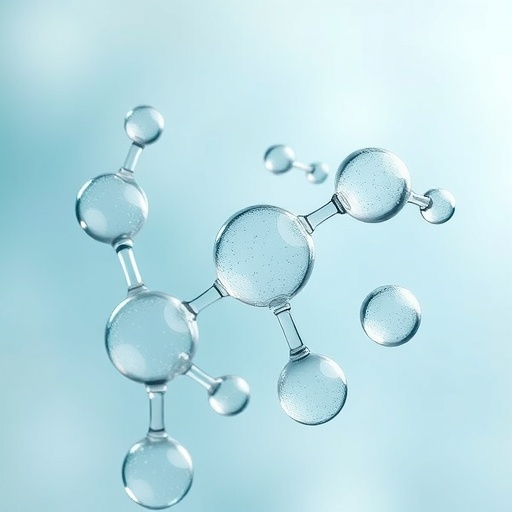In recent years, scientific attention has increasingly focused on the unique properties and potential applications of ionic liquids, particularly dianionic ionic liquids (DAILs). These compounds, characterized by their fully ionic structure and the presence of two negatively charged anions, present intriguing opportunities in various fields including electrochemistry, materials science, and energy conversion systems. The nuanced understanding of how different parameters affect the physical and chemical properties of DAILs is crucial for both academic research and practical applications.
A recent study conducted by Rizehbandi, Khalili, and Ghauri delves into the intricate relationship between the composition of DAILs and their distinct characteristics. Their evaluation particularly emphasizes the effect of varying fluorine atom contents within the ionic liquids. Fluorine, being a highly electronegative element, plays a pivotal role in modulating the interactions within the ionic liquid, thereby influencing its properties such as viscosity, conductivity, and stability.
The significance of this research lies in the systematic exploration of how the introduction of fluorine atoms alters the molecular interactions within DAIL structures. The study employs a comprehensive methodology that involves synthesizing a series of dianionic ionic liquids with different fluorine contents. Through a series of experimental tests, the researchers meticulously measured the physical properties of each variant, allowing for a thorough comparison of behavior across the different compositions.
One of the most compelling findings of this research is the pronounced impact that fluorine content has on the viscosity of DAILs. As fluorine atoms are introduced in increasing quantities, noticeable changes in fluidity are observed. This has direct implications for applications such as electrochemical devices, where lower viscosity can lead to enhanced ion mobility and, consequently, improved performance in energy storage systems like batteries and supercapacitors.
Moreover, the study also addresses the thermal stability of the synthesized DAILs. Thermal stability is a critical factor in determining the usability of ionic liquids under various operating conditions. The introduction of fluorine was found to enhance the thermal stability of certain ionic liquid formulations, making them more applicable for high-temperature applications such as heat transfer fluids or high-performance lubricants.
In addition to viscosity and thermal stability, the study investigates the electrical conductivity of the DAILs. Conductivity is a core property for any ionic liquid that is intended for use in electrochemical applications. The research reveals that the incorporation of fluorine affects the dissociation of ions within the liquid, leading to variations in ionic conductivity. This property is vital for optimizing the efficiency of electrolytes in batteries and other energy conversion systems.
The implications of these findings extend beyond basic science and touch upon key technological advancements. For instance, with an ever-increasing drive towards sustainable energy solutions, understanding how to tailor ionic liquids for specific applications could pave the way for more efficient energy storage systems. By fine-tuning the fluorine content in DAILs, researchers can engineer more effective materials that meet the demands of modern energy systems.
These insights contribute to a broader understanding of ionic liquids and their behavior, setting the stage for future research aimed at uncovering additional properties and potential applications. The innovative approach employed by Rizehbandi and his colleagues not only enhances our knowledge of DAILs but also ignites a discussion on the importance of molecular design in the development of advanced materials.
Further studies will likely explore the relationship between fluorine content and other properties not yet analyzed, such as solubility characteristics and interactions with other solvents or materials. As scientists continue to dissect the complexities of ionic liquids, the role of fluorine and its impact on liquid properties will become an increasingly vital area of investigation.
In conclusion, the groundwork laid by this study represents a significant stride toward harnessing the unique properties of dianionic ionic liquids. As researchers delve deeper into the molecular intricacies of these compounds, the potential for groundbreaking applications in various sectors—ranging from energy to pharmaceuticals—will undoubtedly expand. Ultimately, understanding how to manipulate the building blocks of DAILs could lead to a new frontier in material science, with implications that resonate far beyond the laboratory.
The path forward in this exciting field will be marked not only by continued exploration of fluorine’s effects but also by interdisciplinary collaboration that bridges theoretical research and practical application. Through concerted efforts among chemists, material scientists, and engineers, the vision of utilizing DAILs in everyday applications may soon become a reality.
As the scientific community reflects on these findings, the pursuit of knowledge in the realm of ionic liquids remains ripe with potential. The journey to optimize DAILs is just beginning, and with this foundational research, the future of advanced ionic materials seems brighter than ever.
Subject of Research: Evaluation of characteristics and properties variation of dianionic ionic liquids (DAILs) upon change on fluorine atom contents.
Article Title: Evaluation of characteristics and properties variation of some dianionic ionic liquids (DAILs) upon change on their fluorine atom contents.
Article References: Rizehbandi, M., Khalili, B. & Ghauri, K. Evaluation of characteristics and properties variation of some dianionic ionic liquids (DAILs) upon change on their fluorine atom contents. Ionics (2025). https://doi.org/10.1007/s11581-025-06786-0
Image Credits: AI Generated
DOI: https://doi.org/10.1007/s11581-025-06786-0
Keywords: Dianionic Ionic Liquids, Fluorine Content, Viscosity, Thermal Stability, Electrical Conductivity, Ionic Liquids, Electrochemical Applications, Energy Storage Systems.




